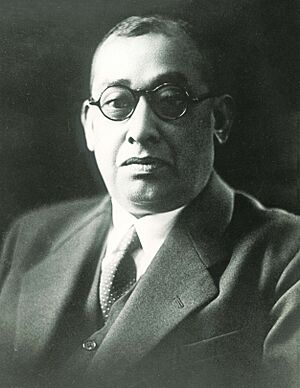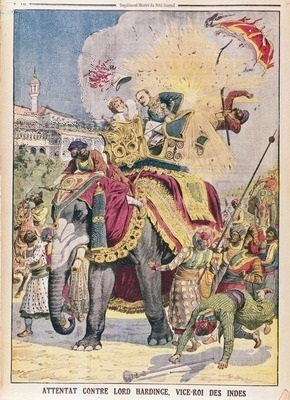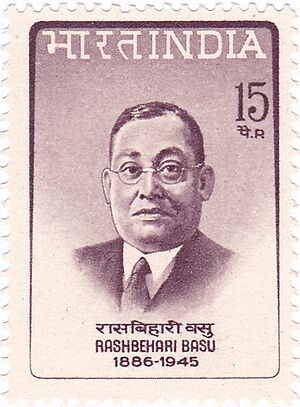Rash Behari Bose facts for kids
Quick facts for kids
Rash Behari Bose
|
|
|---|---|

Bose before 1945
|
|
| Born | 25 May 1886 Village-Subaldaha, Burdwan, Bengal Presidency, British India
(present-day Village Subaldaha, Block-Raina 2, District-Purba Bardhaman West Bengal, India) |
| Died | 21 January 1945 (aged 58) |
| Nationality | Indian |
| Citizenship | British Indian (1886–1915) Stateless (1915–1923) Japan (1923–1945; his death) |
| Organisation | Jugantar, Indian Independence League, Indian National Army |
| Movement | Indian Independence movement, Ghadar Revolution, Indian National Army |
| Spouse(s) | Toshiko Bose (1916–1924; her death) |
| Children | 2 |
| Relatives | Aizō Sōma (father-in-law) Kokkō Sōma (mother-in-law) |
Rash Behari Bose (25 May 1886 – 21 January 1945) was an important Indian leader who worked to free India from British rule. He was a key organizer of the Ghadar Mutiny, a plan to start a rebellion against the British. He also founded the Indian Independence League and helped lead the Indian National Army (INA), which was formed in 1942.
Bose was involved in a plan to remove the British leader in India, called the Viceroy, in 1912. After this plan did not succeed, Bose had to leave India and went to Japan. He worked with Japan against Britain during World War II.
Contents
Early Life and Education
Rash Behari Bose was born on 25 May 1886, in Subaldaha village, which is now in West Bengal, India. He grew up during a difficult time when India faced many challenges under British rule. This made him strongly dislike British control. His father was Binod Behari Bose, and his mother was Bhubaneswari Devi.
Bose spent his childhood in Subaldaha with his sister, Sushila. He also lived with his grandfather's sister-in-law. He started his schooling in his village. Bose heard stories from his grandfather and teacher that made him want to join the freedom movement. People in the village knew him for his strong will. His nickname was Rasu.
Later, Bose moved to Chandernagar to live with his mother's family. There, he studied at Dupleix College. His principal, Charu Chandra Roy, encouraged him and his friends to get involved in politics for India's freedom. Bose later studied at Morton School in Calcutta and also earned degrees in medical science and engineering.
Fighting for India's Freedom
Bose left Bengal to avoid being arrested in 1908. He found work as a clerk in Dehradun. While there, he secretly connected with other freedom fighters from Bengal, Punjab, and other parts of India.
The Delhi Attempt
Bose was involved in a plan to remove the Viceroy of India, Lord Hardinge, on 23 December 1912. After the plan failed, Bose had to hide from the police. He quickly returned to Dehradun and even organized a meeting to condemn the attack, acting as if he knew nothing about it. This helped him avoid being caught.
The Ghadar Movement
In 1913, Bose met Jatin Mukherjee, another important freedom fighter. This meeting gave Bose new energy for his work. During World War I, Bose became a key figure in the Ghadar Mutiny. This was an attempt to start a rebellion among Indian soldiers in 1915. The idea was that with many British soldiers fighting in Europe, it would be easier to win over the remaining soldiers in India.
However, the rebellion failed, and many freedom fighters were arrested. But Bose managed to escape from the British police. He traveled to Japan in 1915.
Life in Japan and the INA
When Bose arrived in Japan, he used a fake name, Priyanath Thakur, pretending to be a relative of the famous poet Rabindranath Thakur. He found help from groups in Japan who supported Asian unity. From 1915 to 1918, he often changed where he lived and his identity because the British government kept asking Japan to send him back to India.
In 1918, he married Toshiko Soma, whose parents owned a famous bakery in Tokyo. They were also supporters of Asian unity. In 1923, Bose became a Japanese citizen. He worked as a journalist and writer. He also helped introduce Indian-style curry to Japan, which became very popular. People even called him "Bose of Nakamuraya."
Forming the Indian National Army
Bose worked with A. M. Nair to convince Japanese officials to support Indian freedom fighters. Japan eventually agreed to help them. Bose organized a meeting in Tokyo in March 1942. At this meeting, they decided to create the Indian Independence League. He also proposed forming an army for India's freedom.
He held a second meeting in Bangkok in June 1942. There, they decided to invite Subhas Chandra Bose to lead the League and the new army. The Japanese had captured many Indian soldiers during battles in Malaya and Burma. These prisoners of war were encouraged to join the Indian Independence League and become soldiers in the Indian National Army (INA). The INA was officially formed on 1 September 1942.
Rash Behari Bose chose the flag for the freedom movement. He then handed over the leadership and the flag to Subhas Chandra Bose. However, the strong organization he had built remained. Rash Behari Bose helped build the Indian National Army, also known as 'Azad Hind Fauj'. Before he passed away from tuberculosis, the Japanese government honored him with a high award called the Order of the Rising Sun.
Personal Life
Bose met Toshiko Soma when he was hiding at her family's home in Tokyo. Her parents, Aizō Sōma and Kokkō Sōma, owned the Nakamuraya bakery and supported Asian unity. They first met when Bose was a fugitive. In 1916, when he was no longer in hiding, Bose invited the Soma family to his house to thank them.
However, Bose, being Indian, stood out in Japan. To help him fit in and apply for citizenship, a friend named Tōyama Mitsuru suggested that Toshiko and Rash Behari get married. After thinking about it for three weeks, Toshiko agreed.
They had a happy marriage that lasted eight years. Bose taught Toshiko Bengali and how to wear a sari. He became a Japanese citizen in 1923. Sadly, Toshiko's health declined, and she passed away in 1924. After her death, Bose never remarried. They were buried together after Bose's death.
They had two children. Their son, Masahide Bose (also called Bharatchandra), was born in 1920. He died at age 24 during World War II. Their daughter, Tetsuko, was born in 1922.
Legacy
In 1943, the Japanese government gave Bose a very high honor, the Order of the Rising Sun, 2nd class.
On 26 December 1967, India's Posts and Telegraphs Department released a special postage stamp to honor Rash Behari Bose. In the city of Kolkata, West Bengal, a street has been named Rash Behari Avenue in his honor.
Images for kids
See also
- Anushilan Samiti
- Hindu–German Conspiracy






